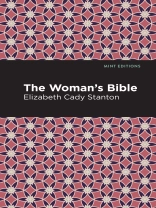The Woman’s Bible (1895-1898) is a work of religious and political nonfiction by American women’s rights activist Elizabeth Cady Stanton. Despite its popular success, The Woman’s Bible caused a rift in the movement between Stanton and her supporters and those who believed that to wade into religious waters would hurt the suffragist cause. Reactions from the press, political establishment, and much of the reading public were overwhelmingly negative, accusing Stanton of blasphemy and sacrilege while refusing to engage with the book’s message: to reconsider the historical reception of the Bible in order to make room for women to be afforded equality in their private and public lives.
Working with a Revising Committee of 26 members of the National American Woman Suffrage Association, Stanton sought to provide an updated commentary on the Bible that would highlight passages allowing for an interpretation of scripture harmonious with the cause of the women’s rights movement. Inspired by activist and Quaker Lucretia Mott’s use of Bible verses to dispel the arguments of bigots opposed to women’s rights and abolition, Stanton hoped to establish a new way of framing the history and religious representation of women that could resist similar arguments that held up the Bible as precedent for the continued oppression of women. Starting with an interpretation of the Genesis story of Adam and Eve, Stanton attempts to show where men and women are treated as equals in the Bible, eventually working through both the Old and New Testaments. In its day, The Woman’s Bible was a radically important revisioning of women’s place in scripture that Stanton and her collaborators hoped would open the door for women to obtain the rights they had long been systematically denied.
This edition of Elizabeth Cady Stanton’s The Woman’s Bible is a classic of American literature reimagined for modern readers.
Since our inception in 2020, Mint Editions has kept sustainability and innovation at the forefront of our mission. Each and every Mint Edition title gets a fresh, professionally typeset manuscript and a dazzling new cover, all while maintaining the integrity of the original book.
With thousands of titles in our collection, we aim to spotlight diverse public domain works to help them find modern audiences. Mint Editions celebrates a breadth of literary works, curated from both canonical and overlooked classics from writers around the globe.
เกี่ยวกับผู้แต่ง
Elizabeth Cady Stanton (1815-1902) was a leader of the U.S. women’s rights movement. Born to a powerful New York family, Stanton was raised by a conservative father and progressive mother. Although both of her parents were politically active—her father was a congressman and later a New York Supreme Court justice; her mother was a campaigner for abolition and women’s suffrage—Stanton, who excelled in school, gravitated toward the radical politics of her mother as she entered adulthood. In 1848, she was instrumental in establishing the Seneca Falls Convention on women’s rights, where she controversially demanded that white American women be granted the right to vote. In 1851, she met Susan B. Anthony, with whom she established several organizations to campaign for abolition and women’s suffrage, shifting during the war to a platform advocating for voting rights to be granted to African Americans and women before opposing the Fifteenth Amendment on the grounds that it afforded African American men the right to vote while denying women the same privilege. After the Civil War, Stanton, alongside Anthony, formed the National Woman Suffrage Association, branching off from the larger suffrage movement to advocate for the right for white women to vote. Despite this controversial decision—she was widely criticized by members of her own movement as well as such prominent African Americans as Frederick Douglass—Stanton remains a crucial figure in the history of women’s rights in the United States.












